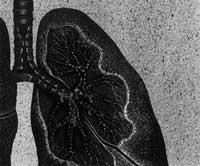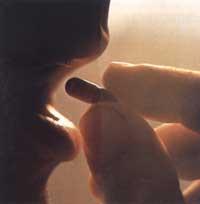Pathology of the respiratory tract (II) pneumonia or yuxt
1993/05/01 Agirre, Jabier - Medikua eta OEEko kidea Iturria: Elhuyar aldizkaria
Pneumonia is inflammation or inflammation of the lung tissue. The affected lung part is condensed and compacted. The air, therefore, cannot access this part.
It is produced at 90% by germs, mainly bacteria and viruses, and in few cases by fungi. Normally pneumococcus is the bacterium that produces pneumonia.
Other causes are the ability to cause biases, such as radiations or inhalation of toxic gases.
Pneumonia occupies fifth or sixth place among the causes of death worldwide, although in recent years this percentage has been significantly reduced. It is more frequent in large cities and in people living in inadequate conditions.
Usually, pneumonia occurs in extreme ages, that is, in early ages (especially in childhood) and in old age.
Since pneumonia is the most frequent pneumatic pneumonia caused by pneumococcus, the following symptoms are presented: usually the onset of bapate, strong chills, chest pain (which increases when breathing), high fever, cough, caraisa (brown color) and severity-shaped weakness.
Pneumonia caused by other bacteria have similar symptoms. The viruses, however, usually start slowly and in addition the pain extends to the whole body (especially the headache), the cough is drier and the carcavities less abundant. On the other hand, there are no chills and the general condition of the patient is not affected so much, since the patient says it is quite well (or at least feels).
Pulmonary X-rays can see if there is condensation in some area (although the suspicion is that auscultation has already been true). Blood should be drawn to determine the germ responsible for the infection through a culture.
In case of bacterial pneumonia, taking antibiotics is prescribed. In case of a virus, the patient will be told to rest and steps will be taken to relieve cough and reduce high fever. They also favor sedatives and inhalations. In more serious cases, oxygen administration may be necessary.
Assistance to patients affected by pneumonia
- Effective treatment only in bacterial pneumonia (with appropriate antibiotic). When there are no drugs to destroy the agents (and this is what happens with viruses), just relieve the discomfort and help recovery. However, these support measures, even with adequate therapy, do not cause any damage.
- The total rest is of maximum importance and affects directly the evolution of the disease. The sick person must be in bed and should only arise to go to the bathroom or when circumstances allow.
- Massages are very suitable to facilitate the drainage of the mucus and help the expulsion of the carcavas, with small strokes in the back, with the patient sitting.
- The patient will take a different position in the bed, depending on the affected lung, always in order to facilitate expectoration.
- The inhalation of vapors is very suitable to soften the mucous membranes. So they are removed more easily and the cough will not be so strong.
Consultation with the doctor Does a pneumonia require hospitalization? Or when is it possible to treat it at home? Pneumonia is something serious, although in strong and young people, with adequate treatment, it has a very good evolution. This possibility of hospitalization or home treatment of the patient, shows in each case the severity of the infection, which is reflected in X-rays and analytical results. In general, people over 50 and/or very young children enter the hospital and other diseases (diabetes, asthma, etc.) Also those who have, when a risk of decompensation of this disease is detected. Admission may be necessary when, for social reasons or for family difficulties, the patient cannot be adequately attended at home. What are the differences and differences between bronchitis and pneumonia? The infection of those who suffer bronchitis (especially chronic) is found in the bronchi and in pneumonia the infection is found in the lungs. Fever, karcavas and cough are symptoms that appear in both diseases, so it is very possible to mix these diseases or processes (especially at the beginning). However, chills usually occur in pneumonia, which on the other hand presents a greater anguish. In any case, the best separator diagnosis is given by chest x-ray: if it is a bronchitis there will be no alteration in the lungs, but if it is pneumonia we will see pulmonary condensation, h.d. a dense stain on the affected lung. If a relative has pneumonia, will those who live with him easily become contaminated? If a person is in good health, he or she has enough defense to not get the disease. And despite living with someone who is affected by pneumonia and inhaling germs that are in the air, their germ will arrive very little to the lungs, since their defense mechanisms (cough, mucus, white blood cells) will be responsible for eliminating them and eliminating them. Only very active germs, such as tuberculosis bacilli, will arrive after inhaling and attack the lung. The most common form of capture of Alborengoa is through the transmission of germs found in his throat. These germs, which are usually found in the pharynx, are usually eliminated when you want to enter the airway. But if the defensive mechanism fails or if many germs manage to penetrate, a lung infection can occur. What are “atypical” pneumonia? Atypical pneumonia is understood to have no normal radiological symptoms and characteristics of conventional pneumonia. In recent years, scientific advances have allowed to identify microorganisms more rare than those that produce conventional pneumonia. Rare or “atypical” does not necessarily mean to be more burdensome than others. But it is important to detect it on time because they require antibiotics other than conventional treatment. Are antibiotics always necessary in these cases? No. Only when pneumonia is caused by bacteria. Today, thanks to antibiotics and a better diet, bacterial pneumonia are less numerous and many of them produced by viruses. These viral pneumonia, when supported by previously healthy people, evolve very well and recover spontaneously. The only treatment is to maintain the general condition of the patient in the best possible way through adequate rest and nourishment and hydration. Hot, antithermal and sedative drinks to relieve cough. Is it possible that something goes from the “throat” and has pneumonia? The entry of food fragments into the respiratory tract facilitates pneumonia. Although it seems rare, the entry of food into the bronchi or lungs occurs more than expected: it usually occurs in people who, being asleep, have vomiting or feed or drink strongly when they are trapped in the opposite throat. Also in people who are anesthetized or when a disease does not ingest properly or the cough reflex disappears. In addition, usually food is accompanied by germs that give rise to pneumonia. If substances come from the stomach, local acid can also cause injury. Aspiration pneumonia is very serious. Therefore, anyone who is not totally awake or clear will never necessarily give food or drink. Is there no pulmonary vaccine? The United States has tested a pneumonia vaccine caused by pneumococci, the most common bacteria. This vaccine provides a fairly effective protection. And it would not be bad that this vaccine was applied to people with greater predisposition to get the disease: cardiac patients, or suffering from bronchopolar diseases; to whom the spleen has been removed (whose defenses are very diminished); to people malnourished, old and generally weakened. On the other hand, the vaccine should never be given during pregnancy, and if children are at high risk they will be vaccinated after six months, repeating the vaccination at two years. |

Gai honi buruzko eduki gehiago
Elhuyarrek garatutako teknologia





